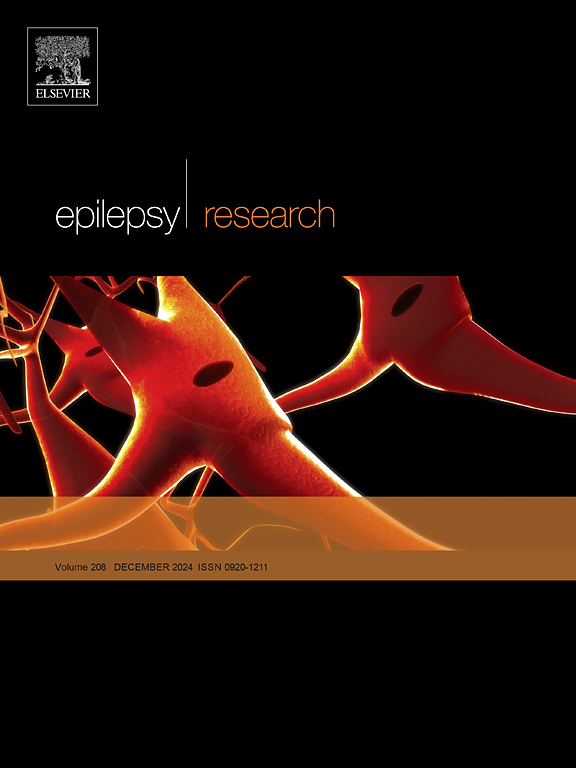Periodic limb movements among persons with epilepsy: A retrospective polysomnographic study
IF 2
4区 医学
Q3 CLINICAL NEUROLOGY
引用次数: 0
Abstract
Introduction
Persons with epilepsy (PWE) frequently contend with disrupted sleep related to multiple seizure related as well as other factors like medications and comorbidities. Such disturbances often lead to fragmented sleep, which can adversely affect quality of life and compromise seizure management. Previous
Although previous research has addressed conditions like sleep apnea and insomnia among PWE, less attention has been paid to periodic limb movements (PLMs), a requirement for diagnosis of the periodic limb movement disorder and also commonly observed in restless legs syndrome (RLS) as well as other conditions. This study aims to determine the prevalence and specific features of PLMs in PWE and to explore how these movements correlate with objective sleep measurements.
Methods
This investigation employed a retrospective chart review of consecutive adult patients diagnosed with epilepsy who underwent polysomnography at a tertiary-care sleep laboratory over a ten-year span. The control group consisted of individuals evaluated for possible obstructive sleep apnea, who were matched to cases based on age, sex, and the severity of sleep apnea. Patient records were initially identified using keywords related to “epilepsy” or “seizures.” Epilepsy diagnosis was confirmed through detailed chart review, which also yielded clinical details likety duration of epilepsy, seizure classification, and antiseizure medication usage. Sleep parameters such as sleep efficiency, spontaneous arousal index, periodic limb movement index, periodic limb movement with arousal index, and apnea-hypopnea index were extracted from archived polysomnography reports. The subsequent analysis was carried out using descriptive statistical methods using RStudio version 4.4.1.
Results
A total of 152 relevant patient records were found in the database. Of these, 61 patients with epilepsy (mean age 41.4 ± 17.2 years, including 31 females) met the inclusion criteria and were matched with 61 patients suspected for OSA. Within the epilepsy cohort, 43 patients experienced focal-onset epilepsy while 16 had generalized epilepsy. 25 patients were prescribed two or more antiseizure medications, and 12 were categorized as medically refractory. PLMs were detected in 23 % of patients with epilepsy compared to 26 % in the control group, with mean PLMI values of 6.1 ± 16.8 and 8.8 ± 20.7, respectively. The PLMAI was also similar between the two groups (0.5 ± 1.0 vs. 1.1 ± 2.4). Other sleep parameters, including the mean AHI (16.0 ± 20.0 in the epilepsy group vs. 19.7 ± 19.4 in the control group), did not exhibit significant differences between groups. Within the epilepsy cohort, the only factor linked to the presence of periodic limb movements was older age, with no observed association with seizure type, number of antiseizure medications, or seizure control.
Conclusions
PLMs are a frequently observed phenomenon in polysomnographic studies of PWE and are predominantly related to advancing age. Given the comparable indices of periodic limb movements in both the epilepsy group and an age- and sex-matched cohort with obstructive sleep apnea, the findings suggest that obstructive sleep apnea might be a major contributor to the periodic limb movements seen among PWE.
癫痫患者的周期性肢体运动:一项回顾性多导睡眠图研究。
引言:癫痫患者(PWE)经常与多次发作相关的睡眠中断以及其他因素(如药物和合并症)作斗争。这种干扰通常会导致睡眠碎片化,这可能会对生活质量产生不利影响,并危及癫痫发作的管理。虽然以前的研究已经解决了PWE中的睡眠呼吸暂停和失眠等疾病,但对周期性肢体运动(PLMs)的关注较少,周期性肢体运动(PLMs)是诊断周期性肢体运动障碍的必要条件,也是不宁腿综合征(RLS)以及其他疾病中常见的症状。本研究旨在确定PWE中PLMs的患病率和具体特征,并探讨这些运动如何与客观睡眠测量相关联。方法:本研究采用回顾性图表回顾,对连续10年在三级保健睡眠实验室接受多导睡眠描记术诊断为癫痫的成年患者进行调查。对照组由可能患有阻塞性睡眠呼吸暂停的个体组成,他们根据年龄、性别和睡眠呼吸暂停的严重程度与病例相匹配。患者记录最初使用与“癫痫”或“癫痫发作”相关的关键词进行识别。通过详细的病历回顾,确认癫痫诊断,并获得癫痫病程、发作类型和抗癫痫药物使用的临床细节。从存档的多导睡眠图报告中提取睡眠效率、自发觉醒指数、周期性肢体运动指数、周期性肢体运动伴觉醒指数和呼吸暂停低通气指数等睡眠参数。后续分析采用描述性统计方法,使用RStudio 4.4.1版本进行。结果:数据库共检索到相关病历152例。其中61例癫痫患者(平均年龄41.4 ± 17.2岁,包括31例女性)符合纳入标准,与61例疑似OSA患者匹配。在癫痫队列中,43例发生局灶性癫痫,16例发生全身性癫痫。25名患者服用了两种或两种以上的抗癫痫药物,12名患者被归类为难治性药物。23 %的癫痫患者检测到PLMs,对照组为26 %,PLMI平均值分别为6.1 ± 16.8和8.8 ± 20.7。两组间PLMAI也相似(0.5 ± 1.0 vs. 1.1 ± 2.4)。其他睡眠参数,包括平均AHI(癫痫组为16.0 ± 20.0,对照组为19.7 ± 19.4),组间无显著差异。在癫痫队列中,与周期性肢体运动存在相关的唯一因素是年龄较大,与癫痫发作类型、抗癫痫药物数量或癫痫发作控制没有观察到关联。结论:在PWE的多导睡眠图研究中,PLMs是一个经常观察到的现象,主要与年龄的增长有关。考虑到癫痫组和年龄和性别匹配的阻塞性睡眠呼吸暂停队列的周期性肢体运动指数的可比性,研究结果表明,阻塞性睡眠呼吸暂停可能是PWE中周期性肢体运动的主要因素。
本文章由计算机程序翻译,如有差异,请以英文原文为准。
求助全文
约1分钟内获得全文
求助全文
来源期刊

Epilepsy Research
医学-临床神经学
CiteScore
0.10
自引率
4.50%
发文量
143
审稿时长
62 days
期刊介绍:
Epilepsy Research provides for publication of high quality articles in both basic and clinical epilepsy research, with a special emphasis on translational research that ultimately relates to epilepsy as a human condition. The journal is intended to provide a forum for reporting the best and most rigorous epilepsy research from all disciplines ranging from biophysics and molecular biology to epidemiological and psychosocial research. As such the journal will publish original papers relevant to epilepsy from any scientific discipline and also studies of a multidisciplinary nature. Clinical and experimental research papers adopting fresh conceptual approaches to the study of epilepsy and its treatment are encouraged. The overriding criteria for publication are novelty, significant clinical or experimental relevance, and interest to a multidisciplinary audience in the broad arena of epilepsy. Review articles focused on any topic of epilepsy research will also be considered, but only if they present an exceptionally clear synthesis of current knowledge and future directions of a research area, based on a critical assessment of the available data or on hypotheses that are likely to stimulate more critical thinking and further advances in an area of epilepsy research.
 求助内容:
求助内容: 应助结果提醒方式:
应助结果提醒方式:


